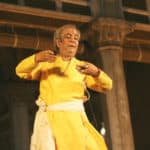Considered to be “one among the group of ten major traditional Indian classical dances” is a dance style/form belonging to North India known as Kathak. This essentially “North Indian” dance form has originated from cities such as Jaipur, Banaras, and Lucknow from states such as Uttar Pradesh and Rajasthan respectively. This dance form is extremely “rhythmic” in nature, and involves the use of hand gestures, upper body movements, and facial expressions to narrate a story. Historically speaking, this dance form has been practiced and passed on from one generation to another orally. In addition, it has also undergone many changes beginning from Akbar’s reign in the 16th century right up to the British Raj.
a. History and origin of Kathak
Like other Indian classical dance forms, the fundamentals of Kathak too is said to have its roots in the sacred Sanskrit text “Natya Shastra”. It is in this text that key elements of this dance form such as the use of the theory of rasa, bhava, expression, hand gestures etc have been mentioned. However, it is said that this dance form actually first took root in the holy city of Varanasi, and then migrated to cities such as Lucknow and Jaipur. Furthermore, the kathak practiced in the city of Lucknow is said to have developed due to the “Bhakti Movement” which was established by Ishwari, a devotee of Lord Krishna.
According to folklore, this devotee apparently envisioned a dream in which Lord Krishna himself appeared before him and requested him to develop a dance form to honour his divinity. In response, Ishwari then developed Kathak in Uttar Pradesh, and passed it on to his descendants. This dance form then underwent evolution starting from the Mughal Era during which sexuality was given more importance that spirituality. This was followed by the British Raj during which this dance form (like many other dance forms in India) was ridiculed, and thereby a ban was suggested by the British establishment and Christian missionaries. Finally it was eventually during the post-independence era, that Kathak once again began to make its presence felt in the society via live public performances.
b. Costumes used in a Kathak performance
The costume used during a Kathak performance will vary according to the gender and religion of the performer. Thus the costume used according to the gender and religion of the performer is as follows:
c. For Male Performer (Hindu):
The costume essentially comprises of a silk dhoti tied around the waist and a scarf wrapped around the neck. In addition, male performers may also wear jewellery.
d. For Female Performer (Hindu):
There are two types of costume used by a Hindu female dance. The first attire is the traditional Indian Saree which is generally wrapped around the waist, while a blouse called “choli” is used to cover the upper body. The other kind of dress used is a long full sleeve light weight skirt. This skirt usually comprises of an embroidered border which helps in highlighting the dance movement. In addition, jewellery especially made of gold also plays a major role in the costume.
e. For female performer (Muslim):
The costume used by a female Muslim performer is a churidar pyjama along with a long coat that covers the hand and the upper body. In addition, a scarf to cover the head as well as light jewellery is used as the part of the costume.
f. Music used during a Kathak performance
A total ranging from two to twelve Indian musical instruments can be used during a performance. The common Indian musical instruments used include the tabla, sarangi also known as the harmonium, and the manjira (hand cymbals).
g. Training available and dance techniques used in Kathak
In terms of the dance technique the performer is supposed to maintain a straight upper body and legs while performing. In addition, the use of hand gestures and facial expressions in sync with the music (similar to many other Indian classical dance forms) are also to be made use of by the performer to narrate the story. As for training there are a number of specialized Kathak schools known “Gharanas” that are available especially in cities in the north such as Benares, Jaipur, and Lucknow. In addition, Kathak taught at “Gharanas” located in each of the cities mentioned above varies in terms of style from one another. In other words, the dance style taught in Lucknow focuses more on emoting i.e. acting, while in Jaipur the focus is more on “dance and footwork”.


